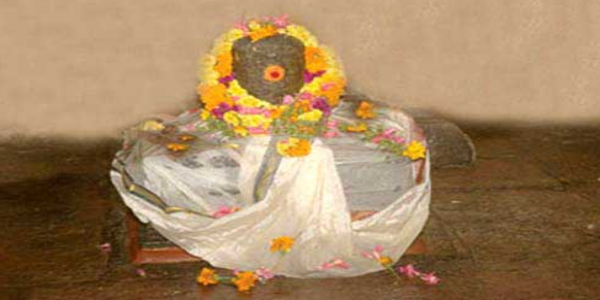Modern science has proved that nine planets revolve around the sun. This astronomical fact was revealed by our ancestors thousands of years ago, without the aid of any modern tools. According to Indian astrology, the nine planetary bodies exert their influence on a human-being. Among all the nine planets, Guru (Jupiter) occupies a position of prominence. Hence said that if Guru is in a favourable position, then one is blessed with immense good fortunes (குருபார்க்க கோடி புண்ணியம்).
It is believed that a person can receive the immense blessings of Guru by visiting the Guru Sthalam (Guru Sthalam) at Murappanadu (முறப்பநாடு). Worshipping Kailasanathar at this temple gives bountiful benefits. This is the Fifth Kailasam (ஐந்தாவது கைலாசம்) and the first among the temples of the Middle Kailasam (நடு கைலாசம்).
Unique Glory of Murappanadu
Murappanadu has a unique speciality among all the Nava Kailasam temples. The reason for this is the River Thamirabarani that flows before this temple. There are only two rivers in India that flow from North to South. One is the River Ganges at Kasi and the other is Thamirabarani at Murappanadu. This river is praised as “Thatchana Gangai” (தட்சண கங்கை) and said that taking a dip in the river here is as beneficial as taking a dip in the holy Ganges at Kasi. The sacred bathing Ghats along the banks of this river are known as “Kasi Theertha Kattam”( காசி தீர்த்த கட்டம்)and “Sabari Theertham” (சபரி தீர்த்தம் ).
Auspicious days to take a dip in this river
- New Moon Day on the Months of Aadi (mid-July to mid-August) and Thai (mid-January to mid-February)
- Last Friday and Saturday of every Tamil month
Reason for the Town’s Name
- Place of Rescue for the Sages
Once, holy sages were tormented by the atrocities committed by a group of demons (Asuras), under the leadership of Soorapadman. The sages stood in form and prayed to the Lord, to rescue them from this heinous act of the asuras. Hence the place acquired its name “Murappanadu” which means “the place where sages stood in order and prayed to the Lord”. (முறை + படி + நின்ற + நாடு = முறப்பநாடு).
“Muraipadi Eswararai Naadi Ninra Oor”(முறைப்படி ஈஷ்வரரை நாடி நின்ற ஊர் ) later became known as Murappanadu. The temple for “Murambeswarar” near this village stands as a testimony to this incident.
The place where that temple is located is now known as “Vasavapuram” (வசவபுரம் ). - Place of Bravery
Another legend says that a brave woman of this village chased away a wild tiger using a winnow (a household appliance for removing impurities from grains). Hence this place came to be called as “Murappanadu - Place of Murambu Stones
There is a flatland full of huge stones called as “Murambu”, in this village. Hence this place came to be known as “Murappanadu” or “the place of Murambu stones”.
Miracle of the Lord at Murappanadu
It is also said that this temple was built by Vallala Maharaja.

Long ago, a Chozha King performed a penance praying for a child. As a result of his prayers, a girl with the face of a horse was born. The king was deeply saddened and engaged in a harsh penance. Lord Shiva was pleased with the king’s prayer and appeared before him. The king wept and explained the plight of his young daughter. He pleaded to the Lord, “Please grant a beautiful face for my daughter”. The Lord replied, “Take a dip in the river Thamirabarani, also known as the Dakshina Gangai and worship the Lord there. You will attain what your heart desires”.
As per the Lord’s command, the Chozha King came to Murappanadu along with his daughter. As soon as they took a dip in the Kasi Theertham and worshipped the Lord, his daughter’s face miraculously turned into a human face. The horse face was accepted by Lord Nandi and one can see the horse faced Nandi idol here. Religious scholars claim that the king then built this temple to show his gratitude to the Lord.
Mention in the History of Ancient India
During the 11th century, when the Vijayanagar Empire was at the peak of its glory, Achutha Devarayar and Rama Rayar, a provincial king, succeeded the great emperor Krishna Devarayar. Vittala Rayan, the brother of Rama Rayar, was the representative of the kingdom in Tamil Nadu. During that time, Vittala Rayan, made this temple as his encampment. After worshipping Guru Bagavan at this temple, he waged war on the King of Travancore, who refused to pay his taxes. He defeated the haughty king and collected the duties for the kingdom. He attacked the Portugese, who planned to ransack and pilfer the loot at Bhagavathy Amman Temple in Kanyakumari and made them retreat.
Unique Ritual at this Temple
It is said that Guru Bhagavan, is all powerful at this temple. Hence, devotees at this temple, follow a unique ritual here. It is believed that if one worships the idol of Dhakshinamoorthy and Sani Bhagavan, by performing nine circumambulations, one can get the blessings of all the nava-grahas.
Magnificence of Stone Sculptures
The sculpture of Lord Hanuman, Kannappar (one among the sixty-three nayanmars), an elephant, a peacock and Komatha (the sacred cow) performing Shiva pooja is mesmerising and makes the onlooker spell-bound. Once at this temple, a female devotee witnessed the divine spectacle of Lord Vishnu, taking the form of his ten avatars at the same time. This scene is found on a stone inscription here. This temple is known as “Sri Anjchel Perumal Temple” and the Lord blesses his devotees with wealth. The “Dasavatara Kattam”(தசவதார கட்டம்) at Thamirabarani demonstrates this manifestation of the Lord.

Panorama of the Temple
- Main Deities
The main deity of this temple is Sri Kailasanathar. The lord’s idol faces east to view directly and bless the devotees who take a holy dip in the waters of River Thamirabarani. Goddess Sivagami Ammai faces south and is present in a separate sanctum. She is the pinnacle of patience and the saviour of all those who come to her with trust. - Architectural Structure & Construction
This temple is on the western banks of Thamirabarani. There are four stages and the first stage, Pandhal Mandapam (பந்தல் மண்டபம்) has ten pillars. Then when we enter the temple, we can see the flag mast and the statue of Lord Nandi, with a horse face. If we walk around the outer courtyard by turning left, we can see the idols of Sura Devar and Ashta Lakshmi followed by the idols of the sixty-three nayanmars and Kanni Moola Ganapathy in the top corner. - Other Deities in the Outer Sanctum
Outside the sanctum sanctorum of Lord Shiva, is the idol of Dakshinamoorthy, the Lord of education, facing south. As we circumambulate the Lord’s sanctum, we can see the idol of Panjalingam (பஞ்சலிங்கம்). At the northern corner is the idol of Lord Muruga with his cohorts Valli and Deiyvanai, followed by Lord Chandiswarar and Sani Bhagavan in the opposite side. At the front of the temple are the idols of Baiyravar, Suriyan and Adhikara Nandi.

Significance of the Temple
- Special Poojas are performed on Thiruvathirai, Shiva Ratri, Pradosham days, on the first of every Tamil month, Guru Peyarchi and Sani Peyarchi. Also daily poojas are performed twice a day.
- This temple is attributed to Guru, and highly beneficial for people belonging to the sun signs Sagittarius (தனுச ராசி) and Pisces (மீன ராசி). If women of these sun signs worship the Lord, then they can attain whatever they wish.
- It is believed that worshipping the Lord at this temple is equivalent to worshipping Lord Shiva at Alangudi.
- One must worship the Lord here to remove obstacles in marriage and to be blessed with a peaceful family life and good health.
- According to Hinduism, a person’s luck is determined by his virtues and sins. Everyone born in this world acquires sins during his lifetime. Hence to seek atonement for the sins, one has acquired and to prevent oneself from doing further sins, one needs the blessings of the Lord. Kailasanathar at Murappanadu rescues his devotees from their sins.
- In today’s world, education is necessary for one’s survival. A person who teaches is known as ‘Guru’. It is believed that ‘Guru Bhagavan’, the teacher of the heavenly Devas, will also help us mere mortals by his guidance and by being our divine guru, when we offer our prayers here.
Restoration of the Temple
Once upon a time, this temple was in a dilapidated condition and the compound walls were badly broken. The pavement in front of the temple that led to the Kaasi Theertha Kattam of River Thamirabarani, had been obstructed by fields. It was difficult and scary to get into this famous temple of bygone years. During that period, the Kailasanathar Narpani Mandram of the village performed huge tasks to restore this temple. The Panchayat Council built a road leading to the river. Due to the joint efforts of the Sri Kailasanathar Thirupani Kulu and the Thoothukudi Sri Rama Bhaktha Seva, this temple was slowly restored. As a result of their endeavours, a road for cars and other vehicles, from the front of this temple to the river has been constructed. Also on 27.01.2008, the Maha Kumbabishegam was done here.
Visit Murappanadu to get the Blessings of Guru

According to a famous Tamil adage, Guru or the teacher occupies an important position in one’s life right after one’s parents. Also, Indian astrology states that Guru rules over one’s life for sixteen years. It is during this period, that Lord Guru blesses one with education, wealth, name, fame and glory. Hence to get the blessings of Guru, one must visit this temple of Middle Kailasam attributed to Guru.
How to Reach Here
This temple is at a distance of 15 kilometres from Tirunelveli. Take the road that branches just before the Thamirabarani Bridge, on the highway from Tirunelveli Junction to Tuticorin. It is at a distance of two kilometres along the lane from the Murappanadu bus-stop. Hence advisable to go here on a car or on a bicycle.
If you are travelling via bus, then you can climb any of the local buses that go to Tuticorin from Tirunelveli New Bus-stand and alight at the Murappanadu bus-stop. The bus no.16, which starts from Tirunelveli Junction, stops at the village of Murappanadu.
Temple Timings
Morning: 7.00 a.m. to 10.00 a.m.
Evening: 5.00 p.m. to 7.30 p.m.

